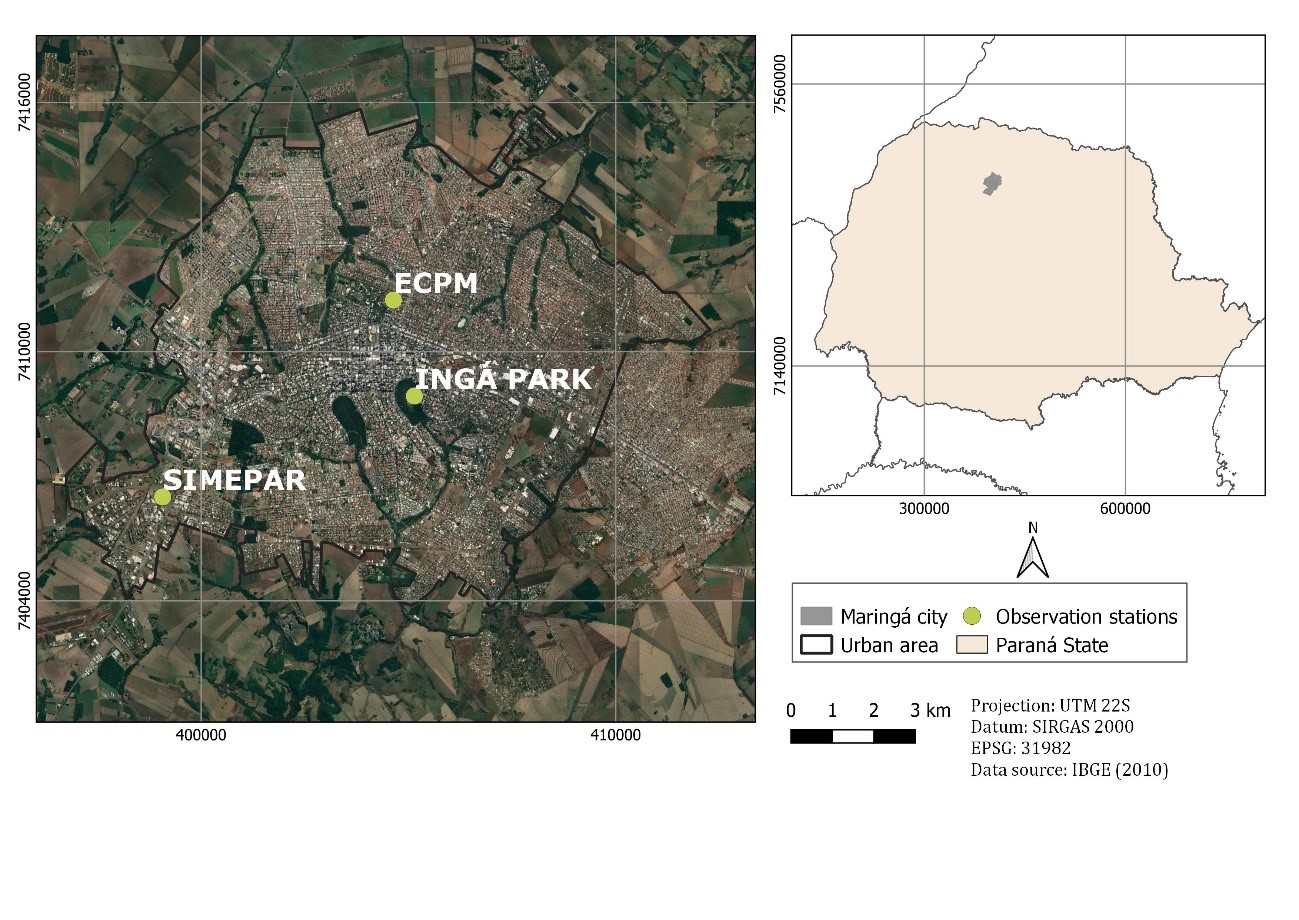Abstract
The complexity of measuring water in its different physical states stems partially from inaccurate recording instruments and limited climatic parameters. As atmospheric composition is variable, researchers use several indexes to describe one of its elements, water vapor. The present research estimates air humidity in Ingá Park, in Maringá city, Paraná State, Brazil. For that, we used relative humidity data obtained from a temperature and humidity recorder inserted in the park. The data refer to the period from April 2019 to January 2020 and from June 2020 to March 2021. We also used remote sensing to verify the amount of precipitable water vapor over the same area in the available time interval of MSI/Sentinel 2A images. Ingá Park has the potential to improve beneficial effects to the city, especially considering the relative humidity and the condition of faster saturation of that observation station. According to the analysis of orbital images, precipitable water vapor in the park was 26,298 mm in 2019 and 25,950 mm in 2020, with a reduction in the first six months in the period from 2019 to 2021. Water vapor estimation through orbital images corroborated the data measured by the fixed sensor. Although these measurements are not equivalent, the study showed a decreasing dynamics of air humidity.
References
BARRY; R. G.; CHORLEY, R. J. Atmosfera, tempo e clima. Tradução: Ronaldo Cataldo Costa. 9. ed. Porto Alegre: Bookman, 2013.
BEVIS, M.; BUSINGER, S.; HERRING, T. A.; ROCKEN, C.; ANTHES, R. A.; WARE, R. H. GPS Meteorology: remote sensing of atmospheric water vapor using the global positioning system. Journal of Geophysical Research, v. 97, n. D14, p. 787-801, 1992. https://doi.org/10.1029/92JD01517
BRASIL. Lei n° 9.985, de 18 de julho de 2000. Disponível em: http://www.planalto.gov.br/ccivil_03/leis/l9985.htm. Acesso: Julho 12, 2021.
BRUBACHER, J. P.; OLIVEIRA, G. G. de; GUASSELLI, L. A. Preenchimento de falhas em séries temporais de precipitação diária no Rio Grande do Sul. Revista Brasileira de Meteorologia, v. 35, n. 2, p. 335-344, 2020. https://doi.org/10.1590/0102-7786352035
DOMINGOS, S.I.S. Microclimatologia do município de Sintra com base em estações meteorológicas. 2008. 89 f. Dissertação (Mestrado em Ciências Geofísicas – Especialização Meteorologia). Universidade de Lisboa, Lisboa, 2008. Disponível em: https://repositorio.ul.pt/handle/10451/1294. Acesso: Agosto 22, 2021.
DUBREUIL, V.; FANTE, K. P.; PLANCHON, O.; SANT’ANNA NETO, J. L. Os tipos de climas anuais no Brasil: uma classificação de Köppen de 1961 a 2015. Confins, n. 37, 2018. https://doi.org/10.4000/confins.15738
EMBRAPA - Empresa Brasileira de Pesquisa Agropecuária. Missão Sentinel. 2021. Disponível em: https://www.embrapa.br/satelites-de-monitoramento/missoes/sentinel. Acesso: Julho 4, 2021.
ESA. Sentinel-2 Products Specification Document. 2021. Disponível em: https://sentinel.esa.int/documents/247904/685211/sentinel-2-products-specification-document. Acesso: Março 15, 2022.
IBGE. Divisão do Brasil em mesorregiões e microrregiões geográficas. Rio de Janeiro: IBGE, 1990. 135 p. Disponível em: https://biblioteca.ibge.gov.br/visualizacao/monografias/GEBIS%20-
%20RJ/DRB/Divisao%20regional_v01.pdf. Acesso: Agosto 8, 2017.
IBGE. Cidades. Disponível em: https://cidades.ibge.gov.br/brasil/pr/maringa/panorama. Acesso: Março 15, 2021.
IBGE. Downloads. 2010. Disponível em: https://ftp.ibge.gov.br/Censos/Censo_Demografico_2010/Resultados_do_Universo/Agregados_por_Setores_Censitarios/. Acesso: Dezembro 19, 2021.
INMET - Instituto Nacional de Meteorologia. Prognóstico climático de outono. 2020. Disponível em: http://www.inmet.gov.br/portal/notas_tecnicas/2020/prognostico_outono_2020.pdf. Acesso: Abril 22, 2020.
INMET – Instituto Nacional de Meteorologia. Banco de dados meteorológicos do INMET (BDMEP). 2021. Disponível em: https://bdmep.inmet.gov.br/. Acesso em: Dezembro 19, 2021.
KASTENDEUCH, P. P.; NAJJAR, G.; PHILIPS, N. Îlot de sécheresse et d’humidité à Strasbourg. Climatology, v. 16, p. 72-90, 2019. https://doi.org/10.4267/climatology.1392
MAGHRABI, A.; DAJANI, Al H. M. Estimation of precipitable water vapour using vapour pressure anda ir temperature in an arid region in central Saudi Arabia. Journal of the Association of Arab Universities for basic and applied sciences, 14:1, 1-8, 2013. https://doi.org/10.1016/j.jaubas.2012.11.001
MARINGÁ. Lei Ordinária n° 880, de 15 de outubro de 1971. Disponível em: https://leismunicipais.com.br/a/pr/m/maringa/lei-ordinaria/1971/88/880/lei-ordinaria-n-880-1971-denomina-parque-do-inga-o-bosque-dr-etelvino-bueno-de-oliveira. Acesso: Março 15, 2022.
MARINGÁ. Lei Ordinária n° 10.353, de 12 de janeiro de 2016. Disponível em: https://leismunicipais.com.br/a/pr/m/maringa/lei-ordinaria/2016/1035/10353/lei-ordinaria-n-10353-2016-dispoe-sobre-a-oficializacao-do-parque-do-inga-prefeito-adriano-jose-valente-como-unidade-de-conservacao-na-categoria-area-de-relevante-interesse-ecologico. Acesso: Agosto 20, 2021.
MELLO, Y. R. de; KOHLS, W.; OLIVEIRA, T. M. N. de. Uso de diferentes métodos para o preenchimento de falhas em estações pluviométricas. Boletim de Geografia, Maringá, v. 35, n. 1, p. 112-121, 2017. https://doi.org/10.4025/bolgeogr.v35i1.30893
MINAKI, C.; MONTANHER, O. C. Influência do El Niño-Oscilação Sul na precipitação em Maringá-PR, no período de 1980 a 2016. Caminhos de Geografia, Uberlândia-MG, v. 20, n. 69, p. 266-281, mar. 2019. https://doi.org/10.14393/RCG206941220
MINAKI, C.; MONTANHER, O. C. Variáveis climáticas e os registros de incêndios em Maringá-PR. Revista Brasileira de Climatologia, v. 27, ano 16, p. 518-538, jul/dez 2020. http://dx.doi.org/10.5380/abclima.v27i0.74403
MORETTIN, P. A.; BUSSAB, W. O. Estatística básica. 8. ed. São Paulo: Saraiva, 2013.
ONO, H. S. P.; KAWAMURA, T. Sensible climates in monsoon Asia. International Journal of Biometeorology, v. 35, n. 1, p. 39-47, 1991. https://doi.org/10.1007/BF01040962
RANSOM, W. H. Solar radiation and temperature. Weather 8, p. 18-23, 1963. https://doi.org/10.1002/j.1477-8696.1963.tb05137.x
R Core Team (2020). R: A language and environment for statistical computing. R Foundation for Statistical Computing, Vienna, Austria. Disponível em: https://www.r-project.org/. Acesso: Janeiro 10, 2020.
RESCHILIAN, P. R.; UEHARA, A. Y. Desafios à questão metropolitana: o processo de organização do espaço urbano e regional de Maringá. Oculum Ensaios, 15, Campinas, p. 76-87, jan-jun. 2012. Disponível em: https://periodicos.puc-campinas.edu.br/oculum/article/view/886/864. Acesso: Março 10, 2022.
SIMEPAR – Sistema de Tecnologia e Monitoramento Ambiental do Paraná. Solicitação de dados [mensagem pessoal]. 2021. Mensagem recebida por cminaki@uem.br em: Outubro 10, 2021.
SUTCLIFFE, R. C. Water balance and the general circulation of the atmosphere. Quarterly Journal of Royal Meteorological Society. 82, p. 385-395, 1956. https://doi.org/10.1002/qj.49708235402
THOM, E. C. The discomfort index. Weatherwise, v. 12, n. 1, p. 57-70, 1959. https://doi.org/10.1080/00431672.1959.9926960
TULLER, S. E. World distribution of mean Monthly and annual precipitable water. Monthly Weather Review, v. 96, n. 11, p. 785-797, nov. 1968. https://doi.org/10.1175/1520-0493(1968)096<0785:WDOMMA>2.0.CO;2
VIANELLO, R.L.; ALVES, A. R. Meteorologia básica e aplicada. 2. ed. Viçosa-MG: Ed. UFV, 2012.
WALLACE, J. M.; HOBBS, P. V. Atmospheric Science: an introductory survey. 2. ed. University of Washington: British Library, 2006. Disponível em: https://www.academia.edu/37366881/Atmospheric_science_wallace_and_hobbs_PDF. Acesso: Julho 26, 2021.
WMO - World Meteorological Organization. Guide to Meteorological Instruments and Methods of Observation. Switzerland: WMO, 2008, n. 8. Disponível em: https://www.posmet.ufv.br/wp-content/uploads/2016/09/MET-474-WMO-Guide.pdf. Acesso: Julho 26, 2021.

This work is licensed under a Creative Commons Attribution 4.0 International License.
Copyright (c) 2021 Cíntia Minaki, Vincent Dubreuil, Margarete Cristiane Costa Trindade Amorim

